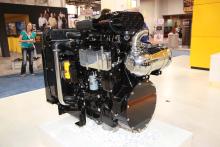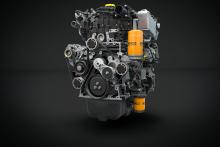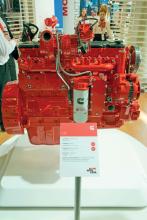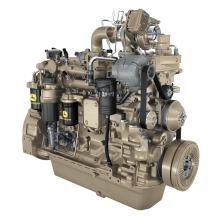
The constant need to meet increasingly tough emission targets is a key factor behind ever more sophisticated construction and quarrying equipment engine technology. Patrick Smith reports.
In recent years engine manufacturers have spent billions developing new products to meet stringent new emissions regulations.
Indeed,
It says that the European Commission is expected to legislate for an increased reduction in emissions in all off-road diesel engines, which is expected to come into force in 2019.
“Europe is leading the way on global emissions targets, and Volvo Penta is excited to be at the forefront of developing new technologies,” says Giorgio Paris, head of Volvo Penta’s industrial segment globally While the Stage V regulations will place more stringent controls on emissions, and apply to all non-road mobile machinery, from lawn mowers to excavators and wheeled loaders, some companies say they are already prepared for the changes.
“Members of the Volvo Group are already using several technical solutions capable of meeting upcoming Stage V regulations, and so Volvo Penta already has access to proven technology,” says Paris In a separate move, and in an ongoing effort to reduce the environmental impact of its products, Volvo Penta has approved the use of hydro-treated vegetable oil (HVO), neat or blended with conventional diesel, in all of its diesel engines.
The approval is based on extensive field testing and endorsement of HVO for on-road use by sister company Volvo Trucks, part of the Volvo Group.
Volvo Penta engines do not need any type approval or specific certification for HVO usage. HVO is a renewable, paraffinic fuel, also known as synthetic diesel, which can be produced from a variety of vegetable and animal sources.
A range of Volvo Penta Stage IV/Tier 4 Final engines were on display at bauma, and are said to have been “extremely well-received by OEMs for many factors, including reliability, robustness and the associated cost-effective maintenance.”
Volvo Penta has chosen an exhaust aftertreatment solution that requires only Selective Catalytic Reduction (SCR) technology, facilitating a simple and flexible installation for OEMs. “As fewer components are used in the manufacturing process, there is less risk of malfunction, maximising uptime and minimising maintenance costs,” says the company.
Meanwhile, other companies were also eager to reveal their latest technologies at
The engines include F3.8, B4.5, B6.7 and L9 variants with capacities from 3.8-9litre and spanning 75-321kW, and importantly all have ditched EGR (exhaust gas recirculation). This creates a mechanically simpler package that delivers more power, more torque and lower fluid consumption, says Cummins, while maintaining the same capacity as the engines they replace.
“Removing EGR allowed us to realise the full potential of the engine for Stage V, without increasing displacement size,” says Jim Fier, Cummins vice president of engineering.
“Our 12litre engine already pointed the way forward for a successful EGR-free design at Stage V, so we were able to cascade this simpler approach down through the power range.”
Larger sumps, with greater oil-holding capacity, play a part in this improvement. Smarter electronics will bring stop-start technology, while a single turbocharger with high efficiency waste gate adds to the simplistic approach.
Exhaust aftertreatment for Stage V will be achieved using a single module, says Fier. This combines a DPF (diesel particulate filter), SCR (selective catalytic reduction) and urea dosing technology in one module, providing a reduction in package size by up to 50%, with a weight saving of up to 30%, Cummins claims.
MAN has two new ranges of off-highway engines that are said to lay the foundation of its EU Stage V emissions regulation strategy.
These include a six-cylinder 15.26litre engine offering outputs from 415-485kW and a larger 24.24litre V12 engine with power outputs from 588-816kW. Both meet Tier 4 Final/EU Stage IV emissions and are also said to be EU Stage V ready.
The six-cylinder engine, D3876 LE12x, uses variable geometry turbo-charging and a 2,500bar fuel injection pressure to manage efficient fuel consumption. It also lowers emissions without compromising on performance, says Jurgen Haberland, MAN’s head of off-road engines.
The D3876 LE12x uses a combination of cooled EGR and diesel exhaust fluid for its SCR exhaust aftertreatment package to meet current emissions legislation. To meet more stringent EU Stage V regulations a DPF will need to be added.
MAN’s larger V12 power unit meets current emissions regulations using diesel exhaust fluid and a dual SCR package, and getting it to meet EU Stage V is said to require the addition of a DPF and changes to the engine control unit. With the SCR package being modular in construction, MAN’s emissions solution simplifies engine installation for OEMs, while the lack of cooled EGR avoids having to make additional cooling pack changes.
As a result, this new version with simplified architecture is lighter than the C9.3 Acert engine, yet produces 18% more power and 18% more torque, to deliver a peak output of 340kW at 2,200rpm and 2,081Nm of torque at 1,400rpm.
Eliminating EGR has eased the load on cooling pack requirements, says the company, while helping to reduce the size of the DPF and SCR aftertreatment package by up to 30%.
TCD 5.0 is the name given to the latest engine from
Using a single turbocharger and charge-air cooling, the latest addition to the TCD engine portfolio uses cooled EGR along with DOC, DPF and SCR to meet Stage V emissions regulations. However, integration of the EGR mechanism as part of the engine block makes the engine easily adapted to less stringent markets using blanking plates and software upgrades.
“We are expecting there to be five levels of emissions regulations that will need to be met for worldwide markets in the short-term,” says Oliver Lythgoe, who is responsible for product concept marketing at Perkins. “And this new platform will let us adapt aftertreatment packages and software to meet regional market emissions from Latin America, China and Russia, for example.”
Power outputs across the range extend from 310-470kW in Stage IIIA guise, and from 340-597kW in Stage IV/V trim.
This will ensure Kubota’s OEM customers have the right engine solution to effectively develop machines that meet emissions targets according to the company, which says the new power packs also provide a ready base for when Stage V emissions legislation does comes into effect.
John Deere Power Systems says its current engine line-up is already capable of meeting the expected Stage V emissions levels as a result of fitting DPF technology to meet current emissions requirements.
It anticipates one of the significant impacts of Stage V to be the introduction of a particle number (PN) limit for engines in the 19-560kW power band, which will force the use of DPF technology.
The company has been employing DPF technology since the introduction of Stage IIIB in 2011, and has amassed more than 150 million DPF hours of in-field use.
“DPF technology is very familiar to us. And our dealer network is comfortable with it too,” says Martin Ryley,
It means Deere engines will continue to use a combination of existing technologies, including cooled EGR, which is said to contribute to the use of a smaller SCR package.
New catalyst technologies and emissions control calibrations will enable downsizing of aftertreatment systems. And the next generation aftertreatment solutions from John Deere are expected to deliver greater package flexibility and easier installation, while providing reductions of up to 20% in size and 40% in weight.
It enables exhaust aftertreatment and SCR systems to be deactivated simply by software, rather than hardware changes, says the company.
“There are no timeconsuming hardware modifications to make. By making a software upgrade, deactivating exhaust aftertreatment systems opens up new market opportunities for those looking to sell used equipment into lesser regulated markets,” says Bernd Kruper, vice president of MTU’s construction and industrial business.









